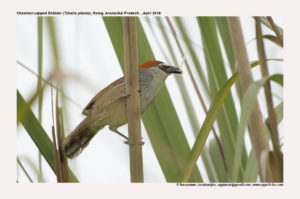
Chestnut-capped Babbler Timalia pileata
Etymology:
- Timalia : Greek word timao -to honour ; helios -sun
- Pileata : Latin word for Capped derived from pileus – felt-cap
Vernacular Names : Cachar: Dao-maogasha gashim, Mikir: Vongnavi, Naga: Ingeto.
Distribution in India:
Resident of Himalayan foothills and North East plains in India.
Description: Size of 15·5–17 cm; Wt. of 15–23 g. It is a medium-sized babbler with rather long graduated tail, thick black bill, black half-mask, white face and breast and chestnut cap. The nominate race has forehead and supercilium as whitish, crown is chestnut, upperparts and upperwing are pale olive-brown with rufescent tinge, vague blackish streaks on mantle, tail is greyer olive-brown with indistinct narrow brownish bars; lores to bill base and area immediately around eye, including narrow postocular eyestripe are black, ear-coverts are whitish, neck side and breast side are mid-grey. The lower face, chin and upper throat are white, lower throat to breast are white with fine black shaft streaks, belly is pale creamy buff. The flanks, thighs and vent are dirty ochrous olive-brown; iris is reddish-brown to crimson; bill is black; legs are dark brown, brownish-grey or brownish-olive. Both the sexes are similar. The juvenile is warmer above than adult, with crown duller, no black streaks on breast, iris brownish-grey. Race bengalensis is darker above than nominate, only slightly rufescent, tail blackish-brown, belly pale olivaceous-buff.
Habitat: It is found in low-lying swampy areas, tall grass, reedbeds, brushwood and scrub-jungle, often along streams and roads, low bushes, thorn hedges and bamboo between cultivation; . It is found up to 1500 m in India.
Food habits : It eats caterpillars, beetles and other insects and their eggs. It is found in pairs during breeding season; otherwise in small parties, often in association with yellow-eyed babbler. It keeps low down in vegetation.
Breeding habits: They breed in Feb–Oct in India and Apr–Sept in SE Asia. The nest is built by both sexes. The nest is a rough ball, oval or dome, with rather large entrance at side, or a deep cup, made of dry coarse grasses, straw, dry bamboo or other leaves and rootlets, scantily lined with fine grasses and rootlets, placed above ground low down in bush or sapling, invariably surrounded by long grass, on spikes protruding from grass nodes, or on ground sheltered by bush or grass tussock. They lay a clutch of 2–5.